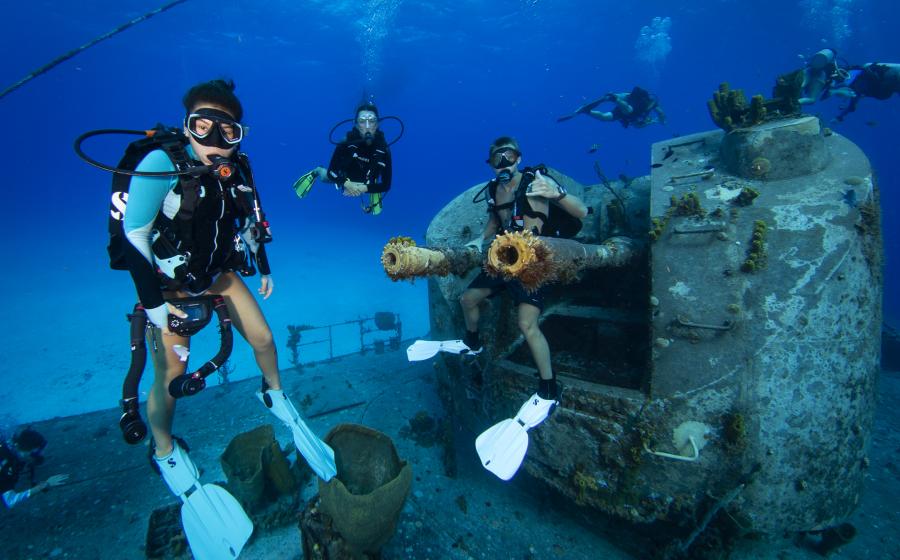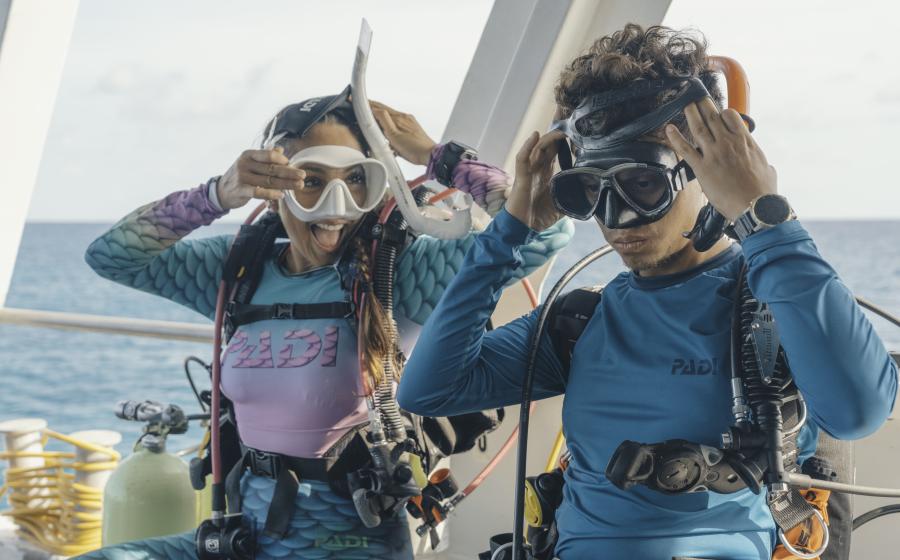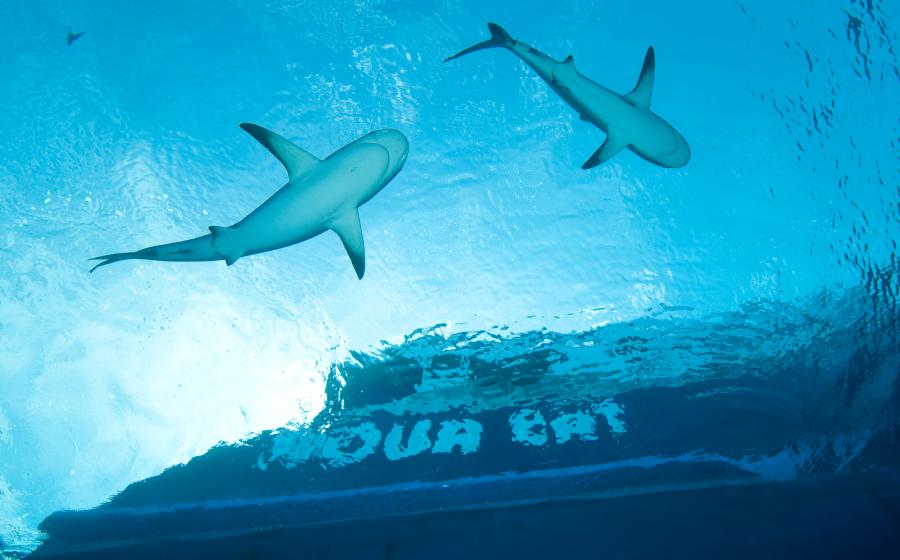Live-aboards Made Easy

By Travis Marshall
It's the diver's dream: Roll out of bed, scarf down some breakfast and walk out the salon door right onto the dive deck where yet another day of unlimited diving stretches out before you in some of the world's most coveted dive destinations. Your every diving whim is catered to. "We like to say, 'we do everything but breathe for you,'" says Wayne Hasson, of Aggressor Fleet. But the very nature of these trips that makes them so attractive--remote destinations, plying the open ocean, perpetually located at the dive site rather than in the heart of civilization--means you need to rethink how you plan your trip. From picking you boat to packing your dive bag, here are 10 tips from the experts for making your next live-aboard adventure the best one yet.
Pick Your Boat
Live-aboard experiences are as varied as boats on the water. From big animal encounters to onsite marine biology lessons, picking the type of adventure you'll have on board is as important as the destination itself. Want to spend a week honing your underwater photo skills? Look for boats with onboard photo pros and underwater photo workshops. Want nonstop diving fun for the whole family? Sign up for a family-oriented trip with dedicated kid programs like scavenger hunts, fish I.D. excursions and water-safety classes. Also, consider the site conditions at your destination, the basic level of experience required to dive there and make an honest assessment of your own diving experience before booking the trip. For example, a trip to the Socorro Islands aboard the Solmar V is geared toward advanced divers because of its remote location, open ocean conditions and proximity to big animals, namely sharks. Air consumption, buoyancy skills and basic comfort in the water are the main considerations for a trip like this. "We let people know it's an advanced dive," says Jose Luis Sanchez, owner of Solmar V. "But there's no way we can qualify divers beforehand, so they need to be honest with themselves when signing up."
Make Requests in Advance
Eat, sleep and dive. That's the draw of a live-aboard trip, and you'll probably have no trouble planning the "dive" part. But don't forget about the other two. Liveaboards are limited in cabin/bunk options, and once at sea, they'll often have spotty access to grocery stores. So, if you want to claim a certain cabin--a centrally located one because you're prone to seasickness, for example--or if you have special dietary needs or preferences because you're vegetarian, lactose-intolerant or just plain picky, make those requests well in advance. "Live-aboard guests must keep in mind that the vessel is serving the needs of up to 20 passengers at one time," says Larry Speaker of Peter Hughes Diving. "We will do our best to accommodate all reasonable requests, but do not wait until two to four weeks before your departure to raise the question of a special need."
Pack Light
Space is at a premium on a live-aboard boat, and all passengers need to share what space there is available. Speaker recommends using only soft, collapsible luggage that will take up little space after it's unpacked. Also, don't stress over what to wear on board. "If you're 'wet' it's probably time to eat, and if you're 'dry' it's probably time to dive," he says. "It doesn't take many wardrobe changes to accomplish that." Multiple pairs of shoes are unnecessary because most time on a live-aboard is spent barefoot, and they take up lots of baggage space. Bring just one pair of boat-friendly footwear. And despite your tropical location, nights at sea--and the air-conditioned interior of the boat--may prove surprisingly chilly, so bring fleece tops and bottoms that'll help you stay warm.
Bring Extras
You'll have few or no opportunities to buy medications, sunscreen or bits and pieces for your dive gear once you've set sail. When packing for your live-aboard trip, pay extra attention to these small essentials:
Extra exposure protection--When you're racking up four or five dives a day, you'll get colder than normal. Consider a thicker suit than you would normally use, bring a shorty or hooded vest to wear underneath and a hood or beanie to throw on if you get chilly.
Save-a-Dive kit--Have spares for most everything in your dive bag. Computer batteries, regulator mouthpieces, fin straps, O-rings--if it can break, it probably will, so be prepared with a backup.
Safety signaling equipment--Whistle, air-powered alert horn, signal mirror, safety sausage, cyalume sticks and/or battery-powered signal lights.
Batteries and chargers for all electronics--cameras, dive computers, flashlights and toys. And bring a travel-size power strip, as plug space may be limited on board.
Toiletries--Shampoo, soap, seasickness, headache, diarrhea and congestion meds, and an ample supply of any necessary prescription medications. "Take everything out of its boxes, and just put them in a large Ziploc in your luggage to conserve space," Speaker says.
Contingency Travel
Depending on your destination, and the number of and types of flights you'll take to get there, you may need to plan your arrival at the live-aboard's departure point for a day or so in advance. "If you can get on a direct flight, you can fly in the same day and get on the boat," Sanchez says. "If you're making a connection, we recommend you come in about one day before." But this varies from boat to boat, so check with your operator for specific advice. "Most all Aggressors have a backup plan for getting guests to the boat should they have flight delays," says Anne Hasson, of Aggressor Fleet. "Only one of our boats, which has to travel 30 hours to its destination, doesn't offer a backup plan."
Take a Specialty Course
Diving's the name of the game on board, and in between dives, you'll need something to pass the time. Take advantage of this opportunity to upgrade your dive skills with some specialty training. "In many cases the 'training' dives for these courses--deep diving, boat diving, drift diving, etc.--are already completed as part of the live-aboard itinerary, and it is really only a matter of adding the academic portion of the course, which is readily available in the evenings or during surface intervals," Speaker says. "But if divers are interested in training, they should make that request early in the planning process. Instructors are readily available, but a live-aboard is not like your local retail dive store where all training manuals, in all languages, are readily available."
Use Nitrox
To get the most out of the rigorous live-aboard dive schedule, or to give yourself an added safety margin, use nitrox for some or all of your live-aboard dives. Don't have your nitrox certification? Take the class on board (see No. 6). "A nitrox certification makes a lot of sense when doing 20 or more dives in a week," Speaker says. "It increases your safety and reduces the risk of decompression sickness. Live-aboard diving typically takes place a good distance away from the nearest recompression chamber and conservative dive practices are encouraged. Anything that a diver can do to reduce their risk of DCS only makes common sense."
Tip Well
The crews working your live-aboard often do double, or even triple, duty. When they're not setting up and breaking down your gear, filling your tanks or guiding your dives, they're cleaning the boat, cooking your meals and making sure everyone stays safe. Standard tip amount on a live-aboard is 10 to 15 percent of your total charter price. Don't be stingy. Do budget tips into your total vacation expense ahead of time. While some operators will let you charge tips to a credit card, keep in mind that the operator will have to pay taxes on that money before it is passed on to the staff, so what you charge on your card isn't the amount the crew will receive. The crew will always appreciate cash.
Get Insurance
Five dives a day for a week straight will redline your nitrogen levels, and many live-aboards operate far off the beaten track. If you get bent, you'll likely need immediate air evacuation to the nearest recompression chamber, and that may not be so "near." Even if dive insurance is not required, you'd be foolish not to have it. The cost of evacuation and recompression can easily run into the tens of thousands of dollars, and DAN's most expensive dive insurance plan (diversalertnetwork.org) costs a mere $70 a year--well worth it. "Along with dive insurance, trip cancellation and interruption insurance will protect the guests' financial investment should the trip be canceled for a covered reason, like weather interruptions, and can assist greatly if something goes wrong during a trip, such as delayed flights or lost bags," Speaker says.
Research the Destination
Do your homework ahead of time to figure out any extra fees you may incur on your trip. Does your live-aboard charge a fuel surcharge? Are there port fees or departure taxes at your destination? What about land-based activities? Many live-aboards will arrange land-based excursions all around your diving destination, so plan those out ahead of time. And, of course, do your dive site homework as well. You want to make the most of this trip, so have a good idea of what you want to do and let the crew know early on. But once you've made your desires known--be flexible. "Each week your crew wants to deliver the best cruise experience possible. They know the destination and environment better than anyone," Speaker says. "Just because you read about a dive site, that may not be the best one for the given week you're on board."

By Travis Marshall
It's the diver's dream: Roll out of bed, scarf down some breakfast and walk out the salon door right onto the dive deck where yet another day of unlimited diving stretches out before you in some of the world's most coveted dive destinations. Your every diving whim is catered to. "We like to say, 'we do everything but breathe for you,'" says Wayne Hasson, of Aggressor Fleet. But the very nature of these trips that makes them so attractive--remote destinations, plying the open ocean, perpetually located at the dive site rather than in the heart of civilization--means you need to rethink how you plan your trip. From picking you boat to packing your dive bag, here are 10 tips from the experts for making your next live-aboard adventure the best one yet.
Pick Your Boat
Live-aboard experiences are as varied as boats on the water. From big animal encounters to onsite marine biology lessons, picking the type of adventure you'll have on board is as important as the destination itself. Want to spend a week honing your underwater photo skills? Look for boats with onboard photo pros and underwater photo workshops. Want nonstop diving fun for the whole family? Sign up for a family-oriented trip with dedicated kid programs like scavenger hunts, fish I.D. excursions and water-safety classes. Also, consider the site conditions at your destination, the basic level of experience required to dive there and make an honest assessment of your own diving experience before booking the trip. For example, a trip to the Socorro Islands aboard the Solmar V is geared toward advanced divers because of its remote location, open ocean conditions and proximity to big animals, namely sharks. Air consumption, buoyancy skills and basic comfort in the water are the main considerations for a trip like this. "We let people know it's an advanced dive," says Jose Luis Sanchez, owner of Solmar V. "But there's no way we can qualify divers beforehand, so they need to be honest with themselves when signing up."
Make Requests in Advance
Eat, sleep and dive. That's the draw of a live-aboard trip, and you'll probably have no trouble planning the "dive" part. But don't forget about the other two. Liveaboards are limited in cabin/bunk options, and once at sea, they'll often have spotty access to grocery stores. So, if you want to claim a certain cabin--a centrally located one because you're prone to seasickness, for example--or if you have special dietary needs or preferences because you're vegetarian, lactose-intolerant or just plain picky, make those requests well in advance. "Live-aboard guests must keep in mind that the vessel is serving the needs of up to 20 passengers at one time," says Larry Speaker of Peter Hughes Diving. "We will do our best to accommodate all reasonable requests, but do not wait until two to four weeks before your departure to raise the question of a special need."
Pack Light
Space is at a premium on a live-aboard boat, and all passengers need to share what space there is available. Speaker recommends using only soft, collapsible luggage that will take up little space after it's unpacked. Also, don't stress over what to wear on board. "If you're 'wet' it's probably time to eat, and if you're 'dry' it's probably time to dive," he says. "It doesn't take many wardrobe changes to accomplish that." Multiple pairs of shoes are unnecessary because most time on a live-aboard is spent barefoot, and they take up lots of baggage space. Bring just one pair of boat-friendly footwear. And despite your tropical location, nights at sea--and the air-conditioned interior of the boat--may prove surprisingly chilly, so bring fleece tops and bottoms that'll help you stay warm.
Bring Extras
You'll have few or no opportunities to buy medications, sunscreen or bits and pieces for your dive gear once you've set sail. When packing for your live-aboard trip, pay extra attention to these small essentials:
Extra exposure protection--When you're racking up four or five dives a day, you'll get colder than normal. Consider a thicker suit than you would normally use, bring a shorty or hooded vest to wear underneath and a hood or beanie to throw on if you get chilly.
Save-a-Dive kit--Have spares for most everything in your dive bag. Computer batteries, regulator mouthpieces, fin straps, O-rings--if it can break, it probably will, so be prepared with a backup.
Safety signaling equipment--Whistle, air-powered alert horn, signal mirror, safety sausage, cyalume sticks and/or battery-powered signal lights.
Batteries and chargers for all electronics--cameras, dive computers, flashlights and toys. And bring a travel-size power strip, as plug space may be limited on board.
Toiletries--Shampoo, soap, seasickness, headache, diarrhea and congestion meds, and an ample supply of any necessary prescription medications. "Take everything out of its boxes, and just put them in a large Ziploc in your luggage to conserve space," Speaker says.
Contingency Travel
Depending on your destination, and the number of and types of flights you'll take to get there, you may need to plan your arrival at the live-aboard's departure point for a day or so in advance. "If you can get on a direct flight, you can fly in the same day and get on the boat," Sanchez says. "If you're making a connection, we recommend you come in about one day before." But this varies from boat to boat, so check with your operator for specific advice. "Most all Aggressors have a backup plan for getting guests to the boat should they have flight delays," says Anne Hasson, of Aggressor Fleet. "Only one of our boats, which has to travel 30 hours to its destination, doesn't offer a backup plan."
Take a Specialty Course
Diving's the name of the game on board, and in between dives, you'll need something to pass the time. Take advantage of this opportunity to upgrade your dive skills with some specialty training. "In many cases the 'training' dives for these courses--deep diving, boat diving, drift diving, etc.--are already completed as part of the live-aboard itinerary, and it is really only a matter of adding the academic portion of the course, which is readily available in the evenings or during surface intervals," Speaker says. "But if divers are interested in training, they should make that request early in the planning process. Instructors are readily available, but a live-aboard is not like your local retail dive store where all training manuals, in all languages, are readily available."
Use Nitrox
To get the most out of the rigorous live-aboard dive schedule, or to give yourself an added safety margin, use nitrox for some or all of your live-aboard dives. Don't have your nitrox certification? Take the class on board (see No. 6). "A nitrox certification makes a lot of sense when doing 20 or more dives in a week," Speaker says. "It increases your safety and reduces the risk of decompression sickness. Live-aboard diving typically takes place a good distance away from the nearest recompression chamber and conservative dive practices are encouraged. Anything that a diver can do to reduce their risk of DCS only makes common sense."
Tip Well
The crews working your live-aboard often do double, or even triple, duty. When they're not setting up and breaking down your gear, filling your tanks or guiding your dives, they're cleaning the boat, cooking your meals and making sure everyone stays safe. Standard tip amount on a live-aboard is 10 to 15 percent of your total charter price. Don't be stingy. Do budget tips into your total vacation expense ahead of time. While some operators will let you charge tips to a credit card, keep in mind that the operator will have to pay taxes on that money before it is passed on to the staff, so what you charge on your card isn't the amount the crew will receive. The crew will always appreciate cash.
Get Insurance
Five dives a day for a week straight will redline your nitrogen levels, and many live-aboards operate far off the beaten track. If you get bent, you'll likely need immediate air evacuation to the nearest recompression chamber, and that may not be so "near." Even if dive insurance is not required, you'd be foolish not to have it. The cost of evacuation and recompression can easily run into the tens of thousands of dollars, and DAN's most expensive dive insurance plan (diversalertnetwork.org) costs a mere $70 a year--well worth it. "Along with dive insurance, trip cancellation and interruption insurance will protect the guests' financial investment should the trip be canceled for a covered reason, like weather interruptions, and can assist greatly if something goes wrong during a trip, such as delayed flights or lost bags," Speaker says.
Research the Destination
Do your homework ahead of time to figure out any extra fees you may incur on your trip. Does your live-aboard charge a fuel surcharge? Are there port fees or departure taxes at your destination? What about land-based activities? Many live-aboards will arrange land-based excursions all around your diving destination, so plan those out ahead of time. And, of course, do your dive site homework as well. You want to make the most of this trip, so have a good idea of what you want to do and let the crew know early on. But once you've made your desires known--be flexible. "Each week your crew wants to deliver the best cruise experience possible. They know the destination and environment better than anyone," Speaker says. "Just because you read about a dive site, that may not be the best one for the given week you're on board."










